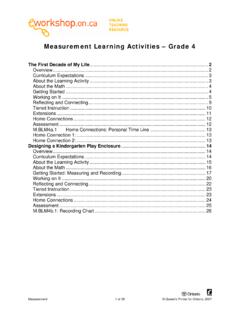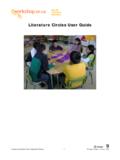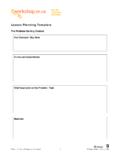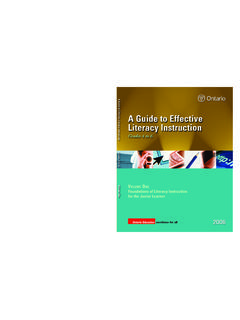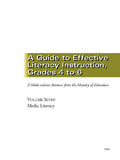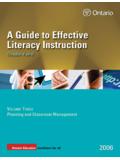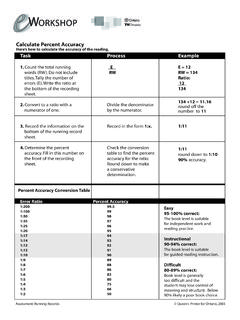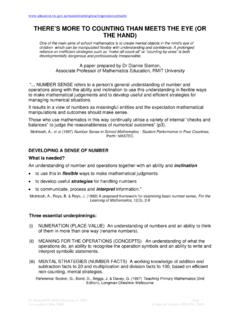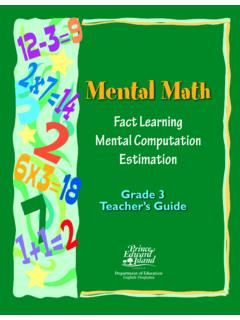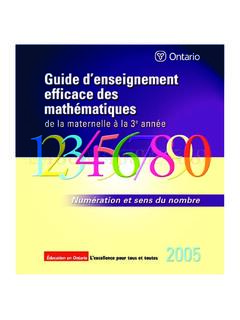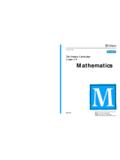Transcription of Lesson Summary: Kindergarten - eWorkshop
1 number Sense and numeration Quantity 1 Queen's Printer for Ontario, 2003 Lesson summary : Kindergarten Overall Objectives This Lesson will help students to: Estimate quantities; Count sets of objects; Group sets of objects into tens; Compare quantities using the terms more, less, and equal. Learning Expectations Students will: Match objects by one-to-one correspondence ( , one cup to one saucer); Km9 Estimate and count to identify sets with more, fewer, or the same number of objects; Km10 Count orally to 30, and use cardinal and ordinal numbers during play and daily classroom routines ( , identify first, second, and third places in a race); Km11 Recognize and write numerals from 1 to 10; Km12 The code that follows each learning expectation comes from the Ontario Curriculum Unit Planner.
2 See for further details. Materials Container (clear plastic bag, tub) holding 20 cubes Container (clear plastic bag, tub) holding 30 cubes Three ten frames for each pair of students Container (bag or tub) holding approximately 50 tiles for each pair of students Home Connections How Many 10 s? game (one per student) Approach Get Started In a guided learning session: Show students a container holding 20 cubes and ask them to estimate the number of cubes in the container. Empty out the contents and count the cubes together. Show students a ten frame. Count the spaces on the ten frame together. Have a few students help you place the cubes on ten frames. Point to each ten frame and ask, How many cubes are on this ten frame?
3 Count the cubes to reinforce the idea that each ten frame holds 10 cubes. Count the total number of cubes on the ten frames. Repeat the activity using 30 cubes. number Sense and numeration Quantity 2 Queen's Printer for Ontario, 2003 Work on It Prepare Students In a guided learning session: Explain to the students that their challenge will be to scoop 30 tiles from a container (plastic bag or tub). (Depending on the readiness of your students, you may decide to use a number less than 30, such as 10 or 20.) Demonstrate the activity by asking a student to take handfuls of tiles from the container until the class thinks that 30 tiles have been scooped. Place the tiles on the ten frames and count the tiles together.
4 Discuss whether more than, fewer than, or exactly 30 tiles were scooped. Explain to the students that they will be doing the scoop-30 activity with a partner. (You may also continue to conduct this activity as a guided learning experience.) Give 3 ten frames and a container holding approximately 50 tiles to each pair of students. Work on It Observe Students In a guided or shared learning session: Observe how well students are able to estimate 30 tiles and place the tiles on the ten frames. Probe students thinking by asking questions such as: - Are you getting better at scooping 30 tiles? Why are you getting better? - How can you use the ten frames to check if you have 30 tiles?
5 Reflect and Connect In a guided learning session: Help students reflect on the activity and their learning by asking questions such as: - Did you get better at scooping 30 tiles? Why do you think you got better? - How did the ten frames help you check to see if you had 30 tiles? - How could you use a ten frame to help you solve other problems? Assessment Observe students to assess how well they: Use one-to-one correspondence when placing tiles on the ten frames; Make increasingly accurate estimates; Determine and explain if the number of tiles they scoop is more than, less than, or equal to 30; Explain their estimation strategies. Extensions/Adaptations Students having difficulty estimating 30 cubes could try to scoop only 10 cubes enough to fill one ten frame.
6 Students needing a greater challenge could scoop a larger quantity of cubes, such as 35 or 40. Students could try the activity using manipulatives that are larger or smaller than tiles, and explain whether they need to take more or fewer handfuls to scoop 30 objects. Home Connections Encourage students to play the How Many 10 s? game with someone at home. Play the game in class, first, to familiarize students with the activity. Ten-Frame Mat number Sense and numeration Quantity Queen's Printer for Ontario, 2003 number Sense and numeration Quantity Queen's Printer for Ontario.
7 2003 Home Connections K & Grade 1 Worksheet How Many 10 s? Using pennies, buttons, blocks, or other small items, play the following game: Place several handfuls of your collection on the table. Take turns estimating how many ten frames you could fill using all the pieces in your collection. Place the items on the ten frame to check your estimate. Did you estimate too many ten frames or too few? Add some items to the collection or take some away, and try the estimating game again and again. See if you can get a closer estimate each time you try! Ten frame

